The iPad Air Review
by Anand Lal Shimpi on October 29, 2013 9:00 PM EST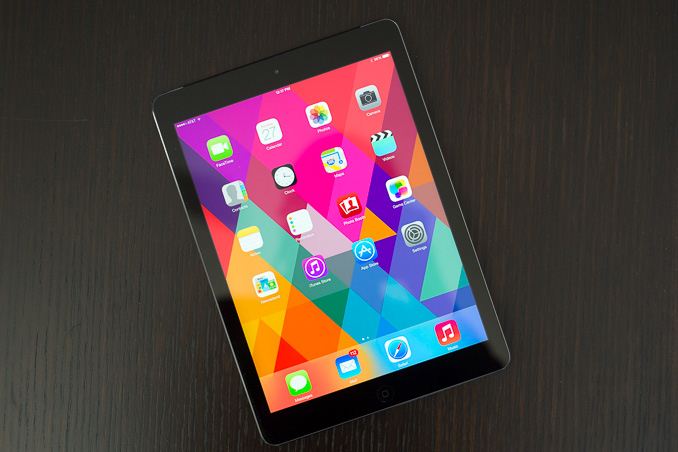
It seemed like a foregone conclusion that the 10-inch tablet market was done for, with all interest and excitement shifting to smaller, but equally capable 7 or 8-inch tablets instead. It also seemed like 15-inch notebook computers were done for a couple of years ago, then Apple launched the MacBook Pro with Retina Display. In a similar vein, last week Apple introduced the iPad Air.
A significant re-imagining of the original 9.7-inch iPad, the Air breathes new life into the platform. Much like the rMBP, the iPad Air borrows a lot of the learnings from its more popular ultraportable counterpart. I don’t know that it will curb enthusiasm over the iPad mini, particularly now that the new mini shares the same hardware platform (including display), but it levels the playing field between the two models.
Trying to summarize what makes the iPad Air special quickly turns into a list of the things Apple likes to have with any evolution of an existing product: it’s smaller, lighter and faster with absolutely no tradeoffs made in the process. The iPad Air feels like a true successor to the iPad 2. If we look at a table charting the progression of physical specs that argument seems even more credible:
| iPad Dimensions/Weight Comparison | |||||||
| iPad | iPad 2 | iPad 3 | iPad 4 | iPad Air | |||
| Height | 243 mm | 241 mm | 241 mm | 241 mm | 240 mm | ||
| Width | 190 mm | 186 mm | 186 mm | 186 mm | 170 mm | ||
| Thickness | 13.4 mm | 8.8 mm | 9.4 mm | 9.4 mm | 7.5 mm | ||
| Weight | 680 g | 601 g | 650 g | 650 g | 469 g | ||
The iPad Air shrinks all dimensions compared to its predecessors, and in some cases does so quite substantially. The best example I have is actually this shot of the iPad 4 resting on top of the iPad Air:

iPad 4 (top) vs. iPad Air (bottom)
The overhang measures nearly an inch, yet the iPad Air features the same 9.7-inch display as its predecessor. Lower power components inside helped reduce the need for a huge battery. The iPad Air moves back down to a more reasonable sized battery (32.4Wh), compared to the downright notebook-sized 42Wh battery from the 3rd and 4th generation iPads. The Air still has a bigger battery than the iPad 2, but the device is still lighter. The smaller battery frees up a lot of internal volume, which allowed Apple to compress the big iPad without shrinking display size.
The visual tradeoff was the same as what we saw with the iPad mini: the iPad Air forgoes a uniform bezel around its display for an uneven design. There’s a rather thick bezel at the top and the bottom, and a narrower bezel along the left and right edges. The whole thing now looks like a bigger iPad mini, rather than a completely unrelated device.
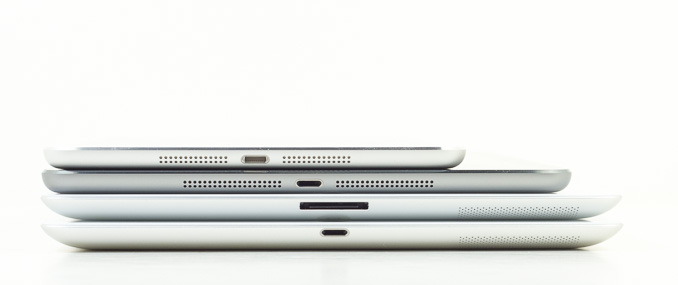
From top to bottom: iPad mini, iPad Air, iPad 2, iPad 4
The thinner bezel around the left/right edges doesn’t pose a problem for using the device. Just as with the iPad mini, Apple does a good job of rejecting your thumbs while they’re resting on the edges of the capacitive display. Sometimes it’s a bit too good of a job as it’ll reject the beginnings of my thumb placement if I'm trying to casually swipe between web pages in mobile Safari, but for the most part it’s seamless and well done. Despite the thinner bezels, you can still use the iPad Air just like you would any prior iPad.
The weight of the iPad Air does its name justice. Without any covers attached the iPad Air weighs an even pound. Even the LTE version tips the scales at just 1.05 lbs. I weighed my LTE review sample at 474 grams, that’s still a lot compared to a 7 or 8-inch tablet, but compared to the 3rd and 4th gen iPads it’s a huge improvement.
The iPad was never light enough for me to comfortably hold in my hands, suspended above my face while lying in bed or on the couch for long periods of time. The iPad 2 got close, but the 3rd and 4th generation iPads reset the scale completely. That’s actually one reason why I liked the iPad mini and Nexus 7 so much, they were far more comfortable to hold.
The iPad Air gets incredibly close. Sans case, the iPad Air is light enough that I can comfortably hold it above me (with two hands) for a while without my wrists getting tired. I still prefer propping the iPad up against something but I think 1 pound may be the crossover point for me personally. With a Smart Cover attached the Air is still passable, it’s only with the Smart Case that I feel like the combination gets a bit too heavy to hold without resting against something for extended use.
One handed use, holding the Air above my face for long periods of time is still tough to do. I always have to prop it up against something rather than hold it like I would a paperback book or magazine. Literally all other use cases however are near perfect with the iPad Air: holding it in two hands, resting it against my palm, looking down at it, suspending it in front of me, or propping it up against my chest/legs. With just a little bit of support, the iPad Air’s perceived weight quickly diminishes to what feels like nothing.
I’ll always take lighter, but the iPad Air strikes a good balance between weight and material quality. There really isn’t another tablet of this size that feels anywhere near as good.
Apple’s insistence on marrying glass and aluminum continues to work, as the iPad Air looks great. The new thinner bezel brings a modern feel to the front, continuing throughout the rest of the device. You now get the same diamond-cut chamfered edges from the iPhone 5/5s and the iPad mini, and the same subtle curve around the sides rather than the steep rake from the iPad 4.
Color options remain at two: space grey and silver. Gold isn’t an option on either the iPad Air or iPad mini with Retina Display. The Air’s space grey looks identical to the finish on the space grey iPhone 5s, although the texture of the two is appreciably different.
I’ve been obsessed with devices that convey the sort of lightweight yet high quality computing slate feel that I always imagined tablets could be. The list of devices that achieves that goal in my mind is pretty limited. The iPad mini did it, as did the 2013 Nexus 7. The iPad Air joins those two in a major way. In fact it’s the first tablet of this size to really feel right. The first iPad looked great but needed improvement on so many vectors. The second gave us a size and weight reduction but lost some of the luxury feel in the process. We know the story of numbers 3 and 4 which amounted to a set of tradeoffs in order to accommodate a Retina Display, but with the iPad Air Apple hits a balance of features, design and ergonomics that I don’t think we’ve ever seen in the iPad.
Hardware
| iPad Specification Comparison | ||||||||
| Apple iPad Air | Apple iPad 4 | Apple iPad 3 | Apple iPad 2 | Apple iPad | ||||
| Dimensions | 240 x 170 x 7.5 mm | 241.2 x 185.7 x 9.4mm | 241.2 x 185.7 x 9.4mm | 241.2 x 185.7 x 8.8mm | 243.0 x 190.0 x 13.4mm | |||
| Display | 9.7-inch 2048 x 1536 IPS | 9.7-inch 2048 x 1536 IPS | 9.7-inch 2048 x 1536 IPS | 9.7-inch 1024 x 768 IPS | 9.7-inch 1024 x 768 IPS | |||
| Weight | 469g (WiFi) | 652g (WiFi) | 652g (WiFi) | 601g (WiFi) | 680g (WiFi) | |||
| Processor | Apple A7 (2 x Cyclone 1.4GHz, PowerVR G6430) |
Apple A6X (2 x Swift, PowerVR SGX 554MP4) |
Apple A5X (2 x Cortex A9, PowerVR SGX 543MP4) |
1GHz Apple A5 (2 x Cortex A9, PowerVR SGX543MP2) | 1GHz Apple A4 (1 x Cortex A8, PowerVR SGX 535) | |||
| Connectivity | WiFi , Optional 4G LTE | WiFi , Optional 4G LTE | WiFi , Optional 4G LTE | WiFi , Optional 3G | WiFi , Optional 3G | |||
| Memory | 1GB | 1GB | 1GB | 512MB | 256MB | |||
| Storage | 16GB—128GB | 16GB—128GB | 16GB—64GB | 16GB—64GB | 16GB—64GB | |||
| Battery | 32.4Wh | 42.5Wh | 42.5Wh | 25Wh | 25Wh | |||
| Starting Price | $499 | - | - | $399 | - | |||
Like the mini, the iPad Air gets two speakers that flank the Lightning connector along the bottom edge of the tablet held in portrait mode. Speaker quality is good, especially considering how thin the device is. Lower frequencies played back at high volumes send notable vibrations through the aluminum chassis, but otherwise the sound reproduction is loud, crisp and generally high quality.

iPad 4 (top) vs. iPad Air (bottom)
In portrait mode, separation between the two speakers is great enough that you do get a stereo effect. Even lightly resting the Air against your body, blocking the speaker grills, doesn’t substantially impact sound quality. In landscape, there’s no getting around the fact that you only have speakers on one side of the device unfortunately. Speaker placement is a tough thing to get right on a tablet. Put them on the sides of a tablet and you potentially hurt portrait use. Pick the top/bottom for speaker placement and you do the same for landscape use. Given the iPad’s 4:3 aspect ratio, there’s a clear optimization for portrait mode. That combined with the plastic RF window along the top to accommodate the cellular antenna on LTE models leaves one location for the speakers.
Up top you’ll find a power/lock button, headphone jack, and for the first time, two microphones. Along the right side you’ll find individual volume up/down buttons, a rotation lock/mute switch and on cellular models a nano SIM card tray. All of the buttons feel clicky and high quality.

iPad 4 (top) vs. iPad Air (bottom)
Neither the iPad Air nor the new iPad mini with Retina Display feature Apple’s Touch ID fingerprint sensor that debuted with the iPhone 5s. Both instead use the same home button as on previous iPads. The absence of Touch ID isn’t a huge issue on a tablet, especially given the vast difference in usage models between a tablet and a phone. My guess is you’re far more likely to repeatedly lock/unlock your phone than a tablet. That’s not to say that Touch ID wouldn’t be useful on the iPad Air. Not having to type in a long password to authenticate with the App Store would be nice, although I’m wondering if Apple would have to reconsider some of the timing limitations on how frequently you need to authenticate to avoid having to manually type in your password. Touch ID on the iPad Air wouldn’t necessarily be a simple port over, but my guess is it didn’t make the cut due to component availability more than anything else.
Pricing on the iPad Air hasn’t changed at all. The entry level model comes with 16GB of storage and WiFi for $499. Each capacity upgrade sets you back another $100, while adding cellular connectivity to any model drives the price up $130.
An interesting side effect of Apple’s pricing structure is that the cost for NAND upgrades actually gets pretty reasonable at the higher capacities. It’s the lower capacities that are the most expensive to upgrade (e.g. moving from 16GB to 32GB will cost you $6.25 per extra GB of storage, downright enterprise NAND pricing, but going from 64GB to 128GB costs you another $1.56 per extra GB).
Cases
The iPad Air’s new dimensions require new cases. Apple updated both of its iPad cases to support the iPad Air. First off is the new $39 Smart Cover.
Apple originally introduced the Smart Cover alongside the iPad 2. Magnets inside the iPad and inside the case attract one another and make getting in/out of the case very quick. I never really appreciated the flexibility of being able to quickly detach the Smart Cover before, but given how light the iPad Air is now I found myself taking the cover off when using the iPad for a long period of time and just quickly re-attaching it before putting the tablet down or going somewhere.
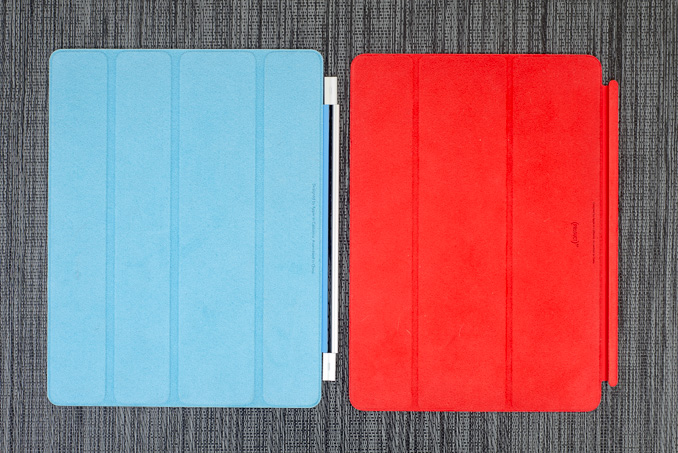
1st gen smart cover (left) vs. iPad Air smart cover (right)
The new Smart Cover moves to a 3-fold design similar to the iPad mini’s Smart Cover. The cover is now all a single piece instead of the more complicated hinge design we saw with the original Smart Cover. The magnets handle alignment incredibly well. Just bring the Smart Cover close to the left edge of the iPad Air and let physics go to work. I don’t know if the strength/size of the magnets inside the cover have changed at all, but the lighter weight of the iPad Air makes it much easier for the cover to support the weight of the iPad if you happen to pick the device up by its attached Smart Cover. It’s not as strong as the connection between a Surface and one of its covers, and you can still get the two to separate if you swing the tablet around, but it’s a far more stable connection than in any of the previous iPads.
Magnets in the opposite end of the Smart Cover are still not strong enough to prevent it from flopping down when flipped around the back of the iPad Air.
Apple also relies on the magnets inside the Smart Cover to sleep/wake the iPad Air. By default, closing the cover will put the device to sleep. Similarly, pulling the cover away from the display wakes it up.
You can still use the Smart Cover as a makeshift stand for the iPad by folding it up. The new design means the iPad stands at a wider angle than with the previous design, tilting the display further away from you when the iPad is fully upright. For desk use I like the new angle, but if you’re using your chest as a prop for the tablet it’s arguably worse. Thankfully the iPad Air is so much lighter than its predecessor that it’s still more comfortable to use lying down, even if you have to partially support the weight of the iPad with your hands.
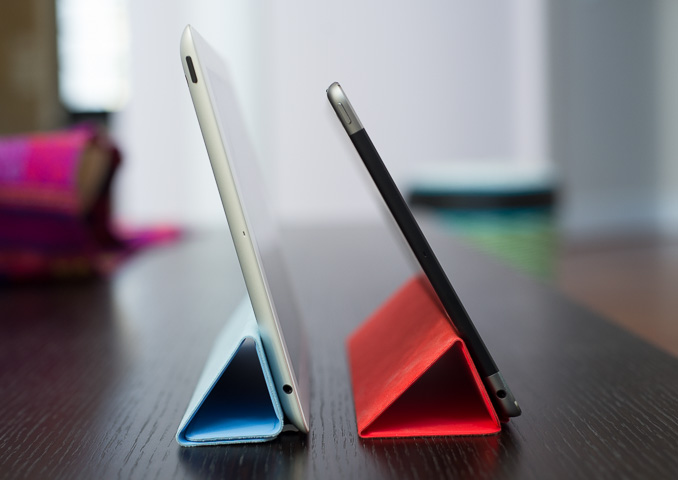
iPad 4 + Smart Cover (left) vs. iPad Air + Smart Cover (right)
The inside surface of the Smart Cover is still made out of microfiber which attempts to help keep your display clean when closed. The outside surface is a soft touch polyurethane. Smart Covers are available in six colors. Apple sampled me a Product Red cover, which I thought was a great fit for the space grey iPad Air.
While the Smart Cover offers screen protection, Apple offers a $79 leather Smart Case that protects all surfaces of the iPad Air. The inside of the case is still microfiber, and you still get the auto lock/unlock features of the Smart Cover. The cover flap also doubles as a stand.
The new Smart Case feel great and seem to do a good job of protecting the iPad Air. The leather feels smooth and doesn’t seem to have the durability issues of the new iPhone 5s leather cases.
Getting the iPad out of the Smart Case does take a little more time as you have to pull it out of a relatively tight tub, so I wouldn’t recommend it as an option if you’re looking to constantly get in/out of the case. There is a more noticeable weight penalty from using the Smart Case as well. As I mentioned before, the iPad Air is light enough that the addition of any case can have a substantial impact on the feel.
Both of the first party case options work really well. The only thing that Apple doesn’t make for the iPad is a case that incorporates a keyboard, although I’m not sure that iOS is in dire need of a physical keyboard either. I can definitely appreciate a convertible/2-in-1, but I’m just not sure iOS is the right platform for such a thing.



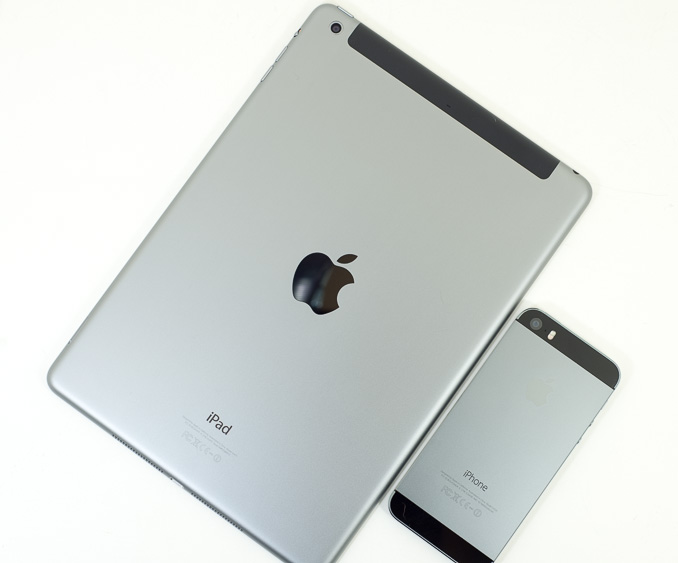






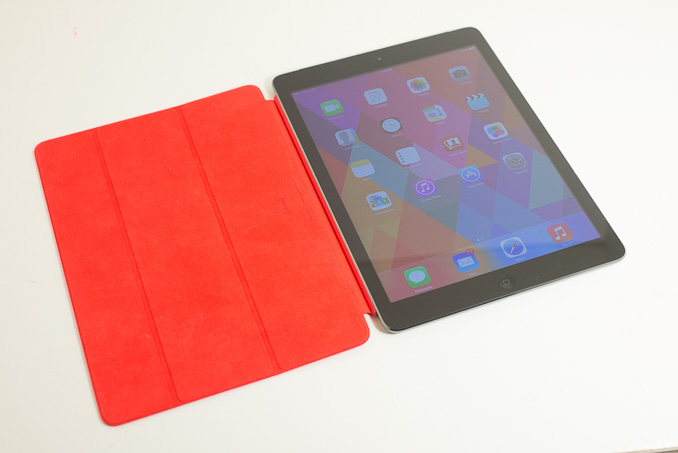
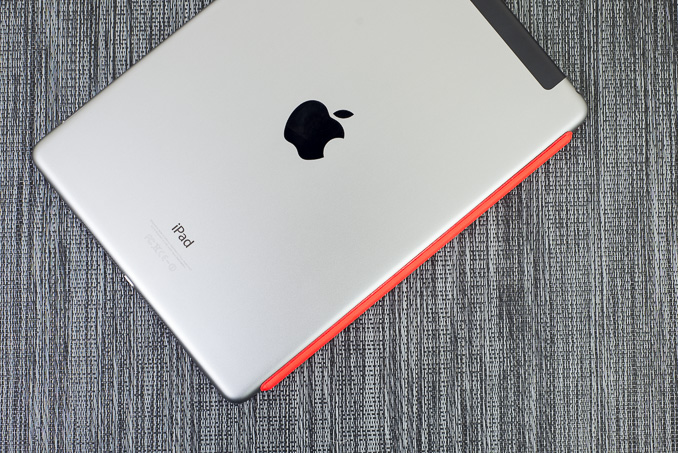
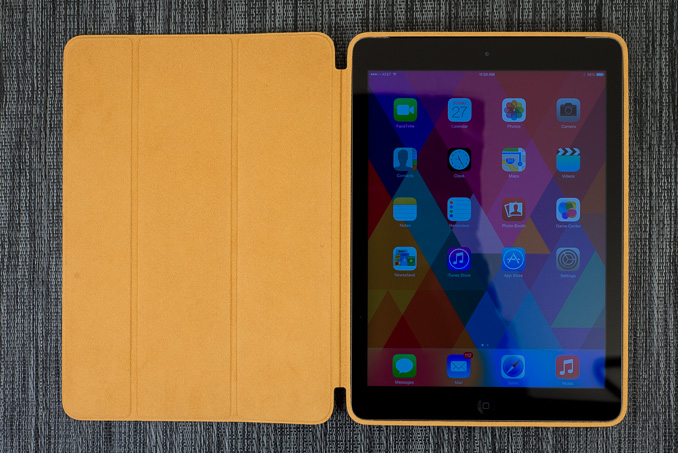















444 Comments
View All Comments
tetsuk - Friday, November 15, 2013 - link
The Macbook Air is great. However, as you mentioned, iWork is not comparable to Office. Since bootcamp works really well, it could still be an option.syedjalalt - Tuesday, November 5, 2013 - link
AnandTech reviews are so unbiased and true unlike The Verge(iSheeps). They go as much deeper as possible to get the best out of their reviews and articles. This is real journalism. Hats off.johned - Tuesday, November 5, 2013 - link
I have a Nexus 4 (soon to be 5) a Nexus 7 first gen and an iPad 2 (soon to be Air). Sometimes I find all the partisan bickering about this stuff hilarious. I like a good row as much as the next guy but I'm a geek. I just love to play with the stuff. I prefer Android to iOS for my daily driver phone, but come on. Anand seems like he's just like me. He loves the tech, all of it, and if had could articulate the way he does, I probably would've started a website like this myself.I will say this, I really don't understand why people think NFC is dead. I use it at least once a day with Google Wallet on my phone. Both major grocery store chains in my area take it. McDonald's takes it. Now, the carrier based service is tanking because they were greedy and botched it. Google wallet I find very useful, though.
Also, I've never had problems transferring files with it. My brother-in-law has a VZW Droid M and I have Nexus devices and I've sent him files from both my tablet and my phone. The most useful thing about it compared to Apple's Air Drop service is that I can do this without needing a wifi connection.
I can honestly say, that the one thing keeping me from an iPhone right now is NFC because I use it so much. If the 5s had included it, I would be sporting one right now. Google Wallet is already available for iOS.
I keep seeing somebody in here sounding like the Apple App Store marketing manager spewing the tired old line about 400blah blah thousand "iPad optimized" apps. This is nice that they are doing that but I observe two things.
1) Google is trying to standardize apps so that 1 app needs to be made for all devices. Since all current Nexus devices have either a 720p or 1080p display, this is easy. This is simply a different approach than Apple is taking.
2)This means that I only need to buy every app 1 time instead of buying it once for my phone and again (usually for a higher price) on my tablet. Apple could mitigate this buy shipping a standard hi-def resolution on the iPhone which they seem reluctant to do.
Back to the original point. We are all geeks here. I appreciate technology. I have opinions about what I like and don't like, but I come to Anandtech because I like to stay current on everything going on. This site also stays largely unpolitical and sticks to the tech, which is why I don't read Ars as much anymore.
JTravers - Wednesday, November 6, 2013 - link
Not sure what you mean about needing a wifi connection for AirDrop. Is having your wifi turned on an issue? AirDrop uses wifi direct, so although you do need to have your wifi turned on you don't need to be connected to a wifi hotspot.nedjinski - Tuesday, November 5, 2013 - link
but wait - there's more -http://www.displaymate.com/Tablet_ShootOut_3.htm
Mayuyu - Wednesday, November 6, 2013 - link
IGZO display instead of IPS. The chart here is wrong.cheshirster - Wednesday, November 6, 2013 - link
Windows tablets are going to suppress ipads sales in coming months.Still no mention in conclusion. That's hilarious, at some point.
AngryCorgi - Thursday, November 14, 2013 - link
Again, you are listing the #s for GFLOPS/core, not the total GPU GFLOPS on the Rogue chips. You need to clarify that. And the older 554MP4 was 21.6 GFLOPS @ 300MHz (14.4 GFLOPS @ 200MHz, as ID'd by Imagination Tech).Atlink - Saturday, November 30, 2013 - link
I'm truly not trying to stir the pot at all, but I am curious about NFC. I understand what it is, and its possible application, however, I'm not seeing anyone really clamor for it. This whole NFC deal seems like the HD-DVD/Blu-Ray war all over again. Neither side really had a lead until Sony began to tip the scales in their favor due to the PS3's exclusive use of Blu-Ray discs for games.I understand that NFC can be used to do some neat things: pay for food, verify a subway ticket, check into a hotel, etc. The problem that I'm seeing is one that anyone without a NFC phone can see: the lack of NFC-enabled terminals. I would say that Apple is dropping the ball something fierce if there were NFC terminals to scan this and that almost everywhere, but like QR codes, they seem almost like a novelty. I *could* scan that code with my phone by either downloading an application that can do it, and then hoping that the code can be read by the program, and hoping that the URL is worth looking at... or I could just type in the URL right below it (yes, I know not everything has a short URL below it). I *could* use NFC by sitting down with my credit cards in advance, creating an account, punching in the numbers, verifying data, opening the app when needed, sorting through the cards I plan to use, selecting the correct one, ensuring the transaction was accepted by the POS... or I could just use my debit card like I have been doing for years now, swipe once, punch in my PIN, and be done with it.
Like I said, I do think that NFC is a really neat idea, and I would love the saturation to become more prevalent in the US, but as of now, it's kind of a neat idea with no real, practical application. I guess the problem I'm having is trying to understand the importance of having it NOW. Some people use NFC as a selling point, and that just seems odd.
I think that when NFC catches on, and you begin seeing it almost everywhere, then we'll start seeing it in Apple products. No point in putting something in if you aren't going to be able to use it, right?
divps - Saturday, November 30, 2013 - link
I have a Nexus 7 and use an iPhone 5. We also have the iPads, a Nexus 4, a Nexus 5 and a Galaxy Nexus phones in the household. I use the Nexus 7 as my tablet for the things that it is strong at and use the nice iOS ecosystem for Apps that I need and that's generally good enough for me. I like the idea of wireless charging and I'm going to get a wireless charger for the Nexus 4 and Nexus 5. The Micro-USB connector isn't the easiest thing to connect without a little effort and the connector can get fatigued over time. It's also nice if you can just come home and put the phone on the platform and pick it up when you need it. The Apple connector is a lot easier for me to put in but wireless charging would mean that I wouldn't need as many lightning cables at home.The Apple ecosystem is generally smoother and nicer. I recently upgraded my Nexus 7 to KitKat and it ran like a dog and I tried a bunch of things and eventually had to do a factory reset which means that I lost a bunch of things and had to re-add them. There are several threads on this on the Phandroid Nexus 7 forums. The iOS 7 upgrade was a piece of cake compared to the KitKat upgrade. I also found UI differences for some simple things between the Nexus 5 and Nexus 7 on KitKat. On the Nexus 7, you do left and right pulldown for notifications and settings. On the Nexus 7, you do one-finger and two-finger pulldowns for notifications and settings. I had thought that the UIs would be the same but I guess not.
I'm extremely impressed with the Nexus 5 hardware - it's very, very fast, great screen, very thin, good feel in hand. I don't like the layout of the volume control and it has known problems with shutter lag and audio output (which I hope will be fixed with software). It's an incredible value for the money.
The thing that I like about Android is the ease of copying content over to them. You just plug them into a PC and drag and drop your files and the Apps will find them on the device. With iOS, I have to convert videos to MP4, or documents to an iBooks compatible format.
I think that the music player and email apps on iOS are far better than the OS provided ones on Android. Google should have done a better job copying iOS Apps there.